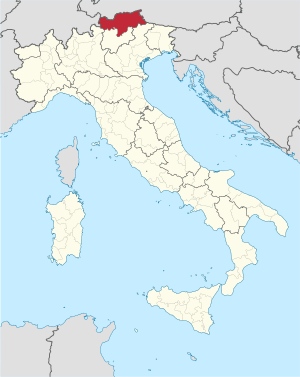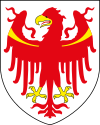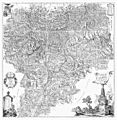South Tyrol facts for kids
Quick facts for kids
South Tyrol
Autonome Provinz Bozen – Südtirol
Provincia autonoma di Bolzano – Alto Adige Provinzia autonoma de Balsan/Bulsan – Südtirol |
|||
|---|---|---|---|
|
|||

Map highlighting the location of the province of South Tyrol in Italy (in red)
|
|||
| Country | |||
| Region | Trentino-Alto Adige/Südtirol | ||
| Capital(s) | Bolzano | ||
| Comuni | 116 | ||
| Area | |||
| • Total | 7,399.97 km2 (2,857.14 sq mi) | ||
| Population
(31.12.2011)
|
|||
| • Total | 511,750 | ||
| • Density | 69.1557/km2 (179.1124/sq mi) | ||
| Time zone | UTC+1 (CET) | ||
| • Summer (DST) | UTC+2 (CEST) | ||
| Postal code |
39XXX
|
||
| Telephone prefix | 0471, 0472, 0473, 0474 | ||
| Vehicle registration | BZ | ||
| ISTAT | 021 | ||
South Tyrol, also called Alto Adige in Italian (German: Südtirol), is a special autonomous province in northern Italy. It's like a state with its own rules. It teams up with the province of Trento to form the region of Trentino-Alto Adige/Südtirol.
This province covers about 7,400 square kilometers (2,857 sq mi). In 2011, around 511,750 people lived there. The main city and capital is Bolzano. South Tyrol shares borders with Graubünden and Lombardy to the west. To the north, it borders Tyrol and Salzburg. In the south, you'll find Trentino and Veneto.
Even though South Tyrol is part of Italy, most people there speak German. About a quarter of the people speak Italian. Most Italian speakers live in the biggest cities, Bolzano and Merano. Both Italian and German are official languages. In some parts, a third language, Ladin, is also spoken and official.
The name South Tyrol is common in English. German and Ladin speakers usually call it Südtirol. Its official name is the Province of Bolzano.
South Tyrol/Alto Adige is an autonomous province. This means it has its own legislature (a group that makes laws). These local laws are often different from those made by the Italian government. The head of the government has been Arno Kompatscher since 2014. He belongs to the South Tyrolean People's Party, which has been in charge since 1948.
What's in a Name?
The name Alto Adige comes from the Adige river. "Alto" means "upper" in Italian. This is because the upper part of the river flows through the province.
The name was first used by the French long ago. They wanted to show that this Italian-speaking area was different from the Austrian empire's Tyrol, which is directly to the north.
A Look Back: History of South Tyrol
Between the Renaissance and the 1800s, the area changed a lot. It was originally settled by people from the Roman Empire. Over time, many German-speaking people moved in. Before Napoleon, only the Dolomite area in the western part of South Tyrol still had people speaking a language similar to Latin.
Austria controlled this land, calling it South Tyrol, until 1918. During this time, Austria tried to make more people speak German, especially after the wars for Italian independence.
After World War I, South Tyrol became part of the Kingdom of Italy. This happened even though most people spoke German. The Treaty of Saint-Germain made this official. The name was also changed to Alto Adige. This was because Italian irredentists (people who wanted Italian-speaking lands to be part of Italy) believed Alto Adige was geographically part of Italy. They also pointed out that the area was mostly "Ladin-speaking" until the 1300s.
The fascist government in Italy also encouraged factories to be built in the province. This was to attract Italian workers to move there. Because of this "Italianization," about 120,000 people (23% of the population) speak Italian as their first language today. In 1960, this number was higher, at 135,000 (35%).
The main political party in South Tyrol is the "Südtiroler Volkspartei." They have had a majority of votes since 1947. This is because so many people in the province speak German. Right after World War II, about 65% of people spoke German. About one-third spoke Italian, and about five percent spoke Ladin. In the 2011 census, the numbers were: 63% German, 23% Italian, and 4% Ladin. Another 10% were immigrants from outside Italy.
Images for kids
-
A map from 1874 showing South Tirol with approximately the borders of today's South and East Tyrol
See also
 In Spanish: Provincia autónoma de Bolzano para niños
In Spanish: Provincia autónoma de Bolzano para niños






















